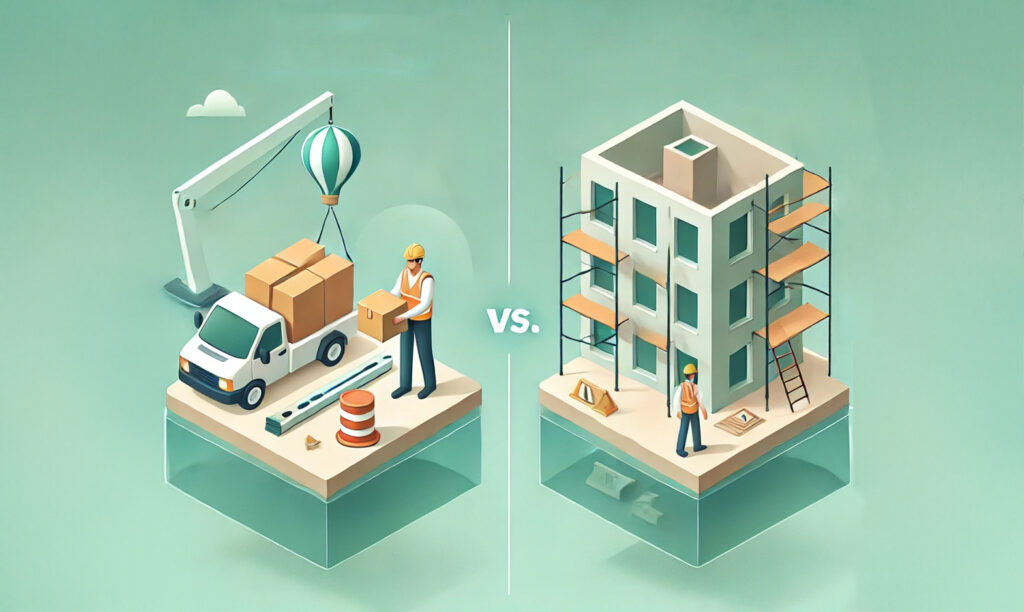Understanding Installation Floater vs Builders Risk

Installation Floater vs Builder Risk is a key consideration when evaluating financial risks in construction projects for both property owners and contractors. With valuable materials, equipment, and structures in play, choosing the right construction insurance coverage is essential to safeguard against potential losses. The two common policies available are installation floaters and builder’s risk insurance, also known as course of construction coverage.
Each policy addresses unique aspects of a project and provides protection at different phases of construction. This article examines installation floater vs builders risk by defining each policy, outlining key features, and offering real-world examples. Contractors, project managers, and insurance professionals can use these insights to guide their coverage decisions and develop an effective insurance strategy.
Definition and Overview for Installation Floater vs Builder Risk
What Is an Installation Floater?
An installation floater is a specialized type of installation insurance that protects materials, equipment, and supplies during the installation phase of a construction project. This installation floater policy is used to insure movable property from the moment the contractor takes possession of the items until the installation is complete or the project is finalized. The installation floater insurance definition includes protection for high-value materials such as HVAC systems, glass panels, or custom fixtures during transport, temporary storage, and the installation process.
What Is a Builder's Risk Policy?
Builder’s risk insurance, also known as course of construction insurance, offers coverage for buildings or projects under construction. This general builders risk insurance policy protects the structure and, in some cases, the materials on-site that will become part of the final construction. Builder’s risk is usually acquired by property owners or general contractors to safeguard the overall investment in new construction or major renovation projects. Coverage generally lasts from the start of construction until the project is complete or the building is ready for occupancy.
Key Components and Features between Installation Floater vs Builder Risk
Both installation floaters and builder’s risk policies have distinct features tailored to different aspects of a construction project. Below is an outline of the primary components of each policy, including various types of installation floaters and what an installation floater covers.
Installation Floater Coverage Features
- Materials in Transit:
The policy covers building materials and equipment as they move from the supplier to the job site. Protection extends to risks such as theft, accidental damage, fire, or weather-related incidents during in-transit transportation. - Temporary Storage:
Items stored at temporary storage locations or at the construction site while awaiting installation are protected under the policy. - Installation Process:
Coverage remains active during the installation process. This protects the property until the work is completed and accepted. - Tools and Equipment:
Many installation floater insurance policies also cover tools and equipment used in the installation process. - Coinsurance Requirement:
Contractors are typically required to carry coverage that equals 100% of the aggregate value of the insured materials, ensuring full protection during the installation phase.
Builder's Risk Coverage Features
- Structure Under Construction:
This policy covers a building or structure from the beginning of the construction process until completion. It includes protection against losses from fire, theft, vandalism, and certain weather-related events. - On-Site Materials:
In many cases, builder’s risk insurance extends to materials present on the construction site, which are intended to become part of the finished building. - Temporary Structures:
Coverage may include temporary installations like scaffolding, fencing, or formwork necessary for the project. - Optional Extensions:
Some policies offer additional coverage options such as soft costs (expenses related to construction delays) and debris removal, which can provide financial support in case of project interruptions.
Comparative Analysis between Installation Floater vs Builder Risk
Online self-paced workers compensation training offers both flexibility and depth. Modules on Worker’ Compensation Laws and practical documentation help professionals manage claims more effectively. Many programs combine self-paced online modules with instructor-led online training, covering everything from basic injury compensation to advanced claims processing, workplace safety, and return-to-work strategies.
| Aspect | Installation Floater | Builder's Risk Policy |
|---|---|---|
| Coverage Scope | Specific materials and equipment during transit, storage, and installation | The entire construction project, including the structure and on-site materials |
| Insured Party | Typically purchased by contractors or subcontractors responsible for a particular installation task | Typically purchased by property owners or general contractors with a financial interest in the overall project |
| Cost/Premium | Lower premium due to a narrower scope of coverage | Higher premiums that reflect the broader and more comprehensive coverage |
| Project Application | Suitable for task-specific work such as installing HVAC systems, glass panels, or other individual components | Ideal for large-scale commercial construction projects or major renovations, where the overall project needs protection |
| Coverage Duration | Short-term coverage, beginning when items are in transit and ending once installation is complete | Coverage spans the entire construction period, from groundbreaking until the project is complete or occupied |
| Coverage of Existing Structure | Not applicable – the policy does not cover any pre-existing buildings or structures | Can include coverage for existing structures on renovation projects if endorsed by the insurer |
| Policy Type | Often a named peril policy | Typically offers all-risk coverage |
Practical Applications and Real-World Examples
When to Choose an Installation Floater
An installation floater application is ideal for contractors who:
Example: A glass contractor transporting and installing custom glass for a bathroom remodel would benefit from a contractors installation floater. This type of installation floater claims examples scenario might involve damage to the glass panels during transit or accidental breakage during installation.
Builder's Risk in Practice
Course of construction coverage, or builder’s risk insurance, is better suited for:
- General contractors overseeing entire projects
- Property owners involved in new construction or major renovations
- Projects where multiple parties need coverage
Example: A general contractor building a new commercial structure from the ground up would require a builder’s risk policy to protect the entire project from start to finish.
Combined Coverage Scenarios
In many large projects, both types of policies may be in place. For instance, while the general contractor’s builder’s risk policy covers the entire construction, individual subcontractors might carry installation floaters for their specialized work. This layered approach helps to isolate responsibilities and minimizes the potential for coverage gaps.
Best Practices and Recommendations
- Match the Policy to the Project Scope: Determine whether your role involves managing specific materials or overseeing the entire build. Contractors focused on individual tasks may benefit from an installation floater, while project owners and general contractors typically need builder’s risk coverage.
- Review the Value of Materials and Equipment: Consider the cost of items you’re responsible for. High-value building materials may require the dedicated coverage of an installation floater, especially if there’s significant risk during transit or installation.
- Evaluate the Project Duration: Installation floaters offer temporary protection that ends once the installation is complete. Builder’s risk policies, however, provide long-term coverage for the full duration of the project.
- Examine Policy Exclusions: Read the policy details carefully. Some builder’s risk policies exclude specific high-value equipment or materials, which may make an installation floater necessary as a supplement.
- Consider an Installation Floater Endorsement: For projects that primarily require builder’s risk insurance but involve certain high-value installations, adding an installation floater endorsement can provide extra protection.
- Consult with an Insurance Professional: Speak with an experienced broker or agent who specializes in construction insurance. They can help you identify any potential gaps and guide you toward the right coverage mix.
- Confirm Project Requirements: Check your contract for any mandated coverage. Many agreements specify which parties need builder’s risk versus installation floater coverage.
- Understand Policy Limits: Ensure that both your installation floater and builder’s risk policy limits are sufficient to cover the full value of your property, equipment, or project.
- Explore Flexible Policy Options: Some insurers offer flexible policy options that let you adjust coverage periods or add/remove coverage types as your project progresses.
Conclusion for Installation Floater vs Builder Risk
Understanding the differences between an installation floater and a builder’s risk policy is vital for anyone involved in construction projects. An installation floater provides focused protection for materials, equipment, and supplies during transit, temporary storage, and the installation process.
When weighing installation floater vs builders risk coverage, remember that each type addresses distinct needs in the construction insurance landscape. Installation floaters typically suit specific tasks or materials, while builder’s risk policies protect the entire project. By evaluating your project’s requirements and consulting with insurance professionals, you can form a solid insurance strategy that meets all contractual obligations and protects your financial interests.
A builder’s risk policy, by contrast, offers comprehensive coverage for the overall construction project, including the structure and on-site materials. Selecting the correct policy—or using both—helps prevent unexpected costs and safeguards your investment throughout the project lifecycle.
Frequently asked questions
Coverage on an installation floater ends when the property is installed and becomes part of a building or structure. At that point, the installed materials would generally be covered by the Builders Risk form.
Builders Risk insurance covers the overall project, while installation floater insurance covers specific building materials and equipment used for installation. Builders Risk is more comprehensive and typically used for larger projects or by general contractors, while installation floaters are often used by subcontractors for specialized tasks.
Generally, installation floater insurance is less expensive than builders risk insurance because its coverage is narrower. However, it may leave the contractor open to certain losses that aren’t covered by the floater.
A builders risk policy can be purchased in the name of either the contractor or the homeowner, depending on the contractual agreements and the financial interests involved.
An installation floater covers building materials while they’re under a contractor’s control, including during transport to a job site, temporary storage on site, and the installation phase. It usually covers losses from fire, theft, and accidental damage.
Many contractors use both types of insurance to protect property at a temporary job site. Builders risk covers the overall project, while installation floater insurance focuses on specific building materials and equipment used for installation.
Common reasons include:
- Timing of installation: Determining when property moves from installation floater coverage to builders risk coverage, especially if items are partially installed.
- Ownership of materials: Deciding whether installed materials belong to the contractor or are considered part of the overall project.
- Scope of coverage: Builders risk policies may exclude certain types of work or equipment that an installation floater covers, leading to gaps or overlaps.
- Completion status: Confusion over when a project or specific segment is viewed as complete, which affects when installation floater coverage ends.
